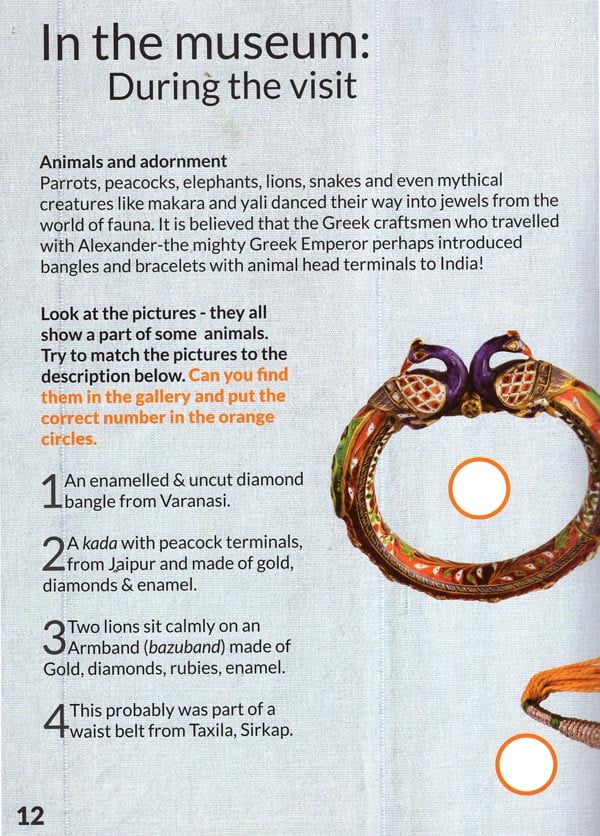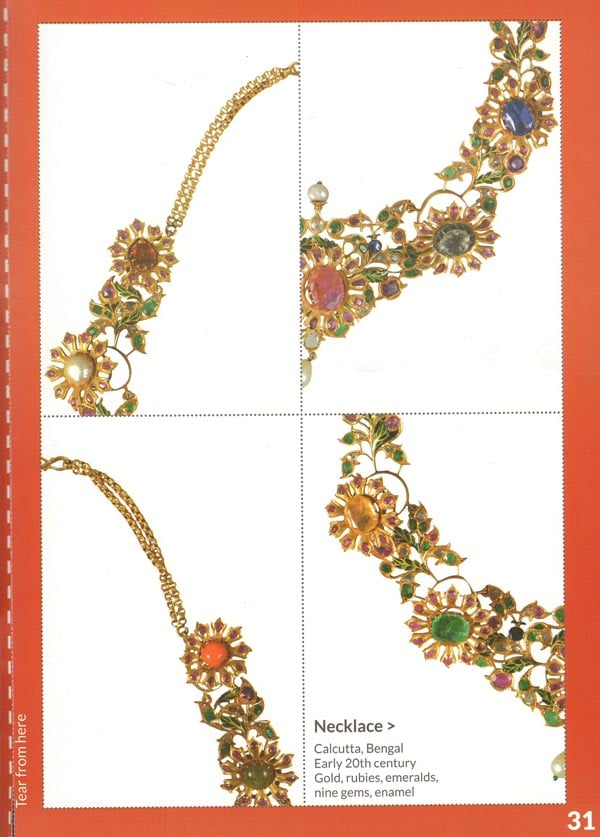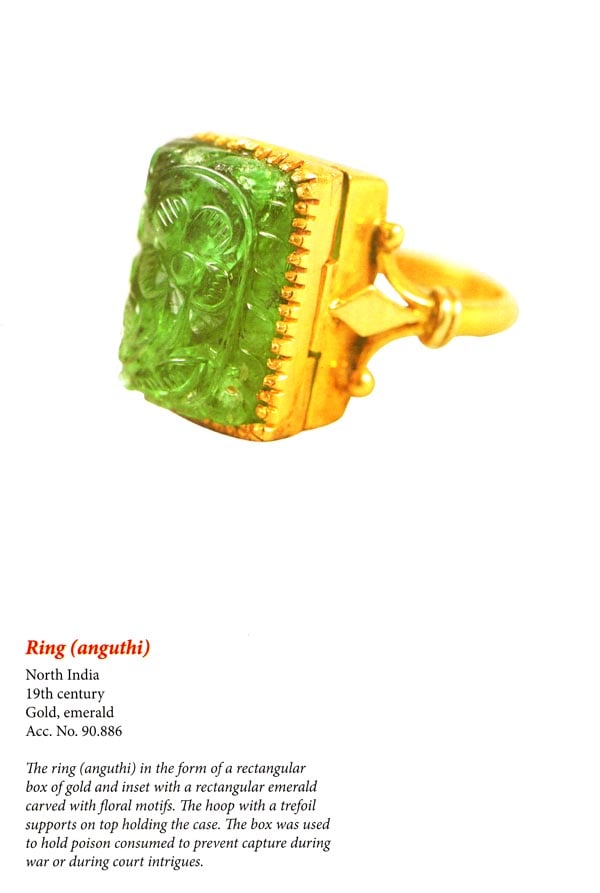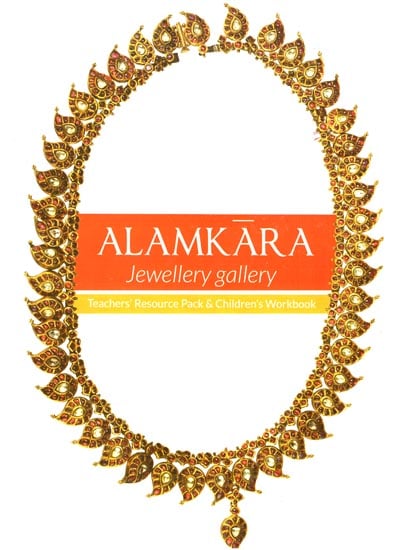
| Specifications |
| Publisher: National Museum, New Delhi | |
| Author: Dr. Usha Balakrishan, Anjan Dey and Hari Om Maurya | |
| Language: English | |
| Pages: 48 (Thorughout Color Illustrations) | |
| Cover: PAPERBACK | |
| 12.00 X 9.00 inch | |
| Weight 390 gm | |
| Edition: 2016 | |
| NAU777 |
| Delivery and Return Policies |
| Usually ships in 3 days | |
| Returns and Exchanges accepted within 7 days | |
| Free Delivery |
This is a teacher resource pack cum children’s workbook. It can be used by teachers or families to plan a visit to the Jewellery Gallery at the Nation Museum (NM). The booklet Has four segments, which include Pre-Visit, During the Visit, Post visit and activities for home.
To promote sustainable creative educational activities Through museum collection NM encourages schools, Teachers and families to opt for planned museum visit And orient children and accompanying facilitators in Classrooms or at home before visiting the museum or Any exhibition.
This booklet is accompanied with 10 selected images of Jewellery from the National Museum’s Jewellery Gallery Which re-opened in 2014. The introduction provided below To the collection can be used by teachers/ facilitators to Understand the collection.
The National Museum collection of jewels celebrates the beauty, design and the technical expertise of Indian craftsmanship. More than two hundred items span the gamut of Indian history and the bulk of the collection dates from the nineteenth and twentieth centuries, and represents communities and regions from around historic India. There are ‘Mughal’ style jewels with kundan set gems in the front and minakari enamelling on the reverse; and, sheet gold necklaces and bangles worked in repoussé from south India. There are hair ornaments for women and turban jewels for men, necklaces that hug the throat and those that cascade down to the waist; there are earrings, armbands, bangles and bracelets. The jewels are set with diamonds, rubies and emeralds, white sapphires and pearls.
The term ‘jewel’ comes from the old French word joule - as something that gives ‘joy’. So, by ‘jewel’ is implied everything that gives joy when worn. It amply sums up what jewellery stands for in the Indian emotional-cultural context. In India, the joy derived from alankara or adornment was not restricted to precious metals or even precious gems. Shells, feathers, bone, ivory, and all kinds of beads were fashioned into body decorations to give pleasure when worn. Jewellery in India was not just a component of attire, but was a passion.
The significance of adornment in Indian culture is manifest in every period and evident in thousands of sculptures, paintings and photographs through the centuries. Most importantly, jewels are intrinsic to the human body in Indian art. The chronicle of Indian jewellery commences in the ancient cities of the idus Valley civilization more than three thousand years before the Common Era. Excavations at Mohenjodaro, Harappa, and other sites have brought forth a treasure trove of beads of different shapes and sizes fashioned from gold, agate, jasper, steatite, carnelian and faience. India was a principal supplier of beads to far-flung cities in the ancient world.
The famous bronze dancing girl from the city of Mohenjodaro is nude but adorned with jewellery. She stands elegantly her left arm hanging down resting on her thigh stacked with bangles from the wrist all the way up to her shoulder. On her right arm, which is bent at the elbow and placed on her hips, she wears just two bangles - one at the wrist and the other just above the elbow. Around her neck hangsa cord with a pendant of three pod-shaped beads. Another bronze fragment of an elegant foot, also from Mohenjodaro wears a beautiful anklet. Simple terracotta figurines are heavily ornamented with jewels - strips and bit’s of clays are applied as necklaces, chokers, bangles and girdles. Jewels from the Indus Valley in the museum's collection manifest a sophistication of design and skilled craftsmanship by artisans of this early pre-historic period.
The many invasions of India from Alexander to Babur resulted in a dispersion of jewellery styles from Greece, Persia and Central Asia into India. From the 16th century the Portuguese, the English and the French brought their own influences to bear. Itinerant craftsmen carried their trade and skills across kingdoms and courts. All these interactions exposed local craftsmen to new design influences and techniques they absorbed, assimilated and reinterpreted and what emerged was a unique and distinct Indian style of jewellery. Gold predominates in the jewels of India as seen in all the pieces in the collection. Gold is the symbol of the sun. From time immemorial, Indians coveted gold for it’s indestructibility and endowed it with properties that went far beyond it’s utility in the manufacture of jewels. The ancient goldsmith discovered that gold was easy to work with. It was malleable, ductile and never lost it’s lustre. The soft metal was ideal to fashion the hollow receptacles into which gems were set. Gold could be drawn into fine wires and twisted into intricate designs, formed into granules and applied to surfaces; gold could be beaten into thin sheets and designs pushed into relief, it could be engraved and incised with beautiful floral patterns. Most importantly, the metal could be melted down and reused to fashion new items.
Nature was an infinite source of inspiration. From the world of flora the jeweller incorporated flowers, buds, leaves, scrolling vines and even fruit’s into the forms and decorations of the jewels he designed. Craftsmen also drew upon the vast storehouse of myths and legends to decorate jewels. Jewels functioned as portable shrines featuring the favourite deities of a devout patron. Jewels such as these were believed to bestow continuous blessings, good health and prosperity on the wearer.
European influence in the 19th century introduced new designs, ornament types, and techniques of production into India. Traditional goldsmiths quickly adapted to the new influences and changing tastes and manufactured jewels that were western in design incorporating lighter mounts, claw setting and faceted gems. The ancient, the traditional and the modern endures side-by-side in India today. Nowhere is this more evident than in jewels. Surviving pieces from the various periods, dynasties and regions of India are few. This is partly due to the turbulent nature of transition of power from one ruler to his heir, from one dynasty to the next and recurring invasions. Turbulence resulted in treasuries being looted and gold being consigned to the melting crucible.
But Indians loved gold and for more than five thousand years India was known as the Golden Bird or ‘sone ki chidia’. It was a land of natural beauty, divine intellect and incalculable wealth. People from around-the world flocked to this golden land lured by the abundance of diamonds, pearls, rubies and emeralds that were traded in gem bazaars around the country.





Send as free online greeting card

Visual Search